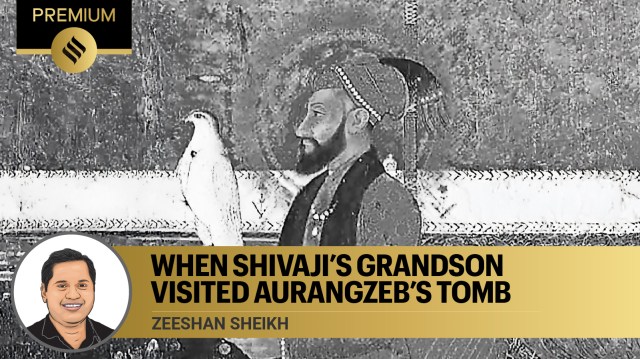
Calls for the demolition of Mughal emperor Aurangzeb’s tomb in Khuldabad, Chhatrapati Sambhajinagar district, have gained traction of late, with Maharashtra CM Devendra Fadnavis leading the charge. Besides Satara MP Udayanraje Bhosale, the descendant of Maratha king Chhatrapati Shivaji Maharaj, labelling Aurangzeb a “thief”, Chhaava, a recently released film that graphically depicts Maratha king Sambhaji Maharaj’s execution, has fuelled the demolition demand.
However, this demand stands in stark contrast to the approach adopted by the Maratha rulers of the past. During the Maratha Confederacy from 1674 to 1818, there existed a more nuanced relationship with Mughal monuments. The Marathas, while asserting their own political and cultural identity, also maintained a respectful engagement with these structures. Historical records mention Chhatrapati Shahu I, the fifth ruler of the Maratha Empire and Shivaji’s grandson, visiting Aurangzeb’s tomb to pay his respects.
Aurangzeb, the sixth Mughal emperor, passed away on March 3, 1707, at the age of 88 in Ahmednagar, present-day Maharashtra. His death marked the conclusion of his 49-year reign, with the last 25 years dominated by fierce battles against the Marathas, led by Shivaji. Despite the constant warfare, Aurangzeb developed a deep spiritual connection with a region called Rauza, located just 26 km from modern-day Aurangabad. Known for its large number of Sufi saints, it was in this area that Aurangzeb sought solace during his turbulent reign.
In his will, Aurangzeb explicitly expressed his desire to be buried near the shrine of Sufi Zaynuddin Shirazi. Though he passed away in Ahmednagar, his body was transported to Khuldabad, located 136 km away, and laid to rest in accordance with his wishes. While the place was originally called Rauza, it was later renamed Khuldabad, meaning “heavenly abode”, as a tribute to Aurangzeb, who was posthumously referred to as “Khuld Makaan” or “the one whose abode is heaven/eternity”.
Aurangzeb’s tomb remains modest. He himself is documented to have funded his final resting place with just Rs 14 and 12 annas — the amount he earned by knitting caps during his last years. The Archaeological Survey of India (ASI) describes the tomb as follows, “The existing gateway and domed porch were added in 1760 AD. The floor is of marble, a neat railing of perforated marble is on three sides, and the wall of the dargah forms the fourth side. It was erected by the Nizam of Hyderabad. Only a patch of earth with a small sabza plant remains on top, and it is roofed only by the vault of the sky.”
Aurangzeb’s death in 1707 marked a turning point in Indian history, paving the way for the Marathas to emerge as the dominant political force in the subcontinent. Despite the long-standing animosity beween the Marathas and the Mughals — especially with Aurangzeb executing Sambhaji Maharaj, the father of Shahu I — his tomb was largely left undisturbed.
Historical records suggest that Shahu I, upon his release following Aurangzeb’s death, visited the tomb of the Mughal emperor. Shahu, who was imprisoned by the Mughals at the age of seven and spent 18 years in their courts, had every reason to harbour resentment towards Aurangzeb, particularly after his father’s execution in 1689.
Shahu’s visit is mentioned in V G Khobrekar’s Maratha Kalkhand, a history of the Maratha state published by the Maharashtra government: “In just a few days, Shahu Raje became beloved by the people. Love and admiration from the public poured in from all sides. After the monsoon season ended, Shahu Raje reached Ahmednagar. He stayed there until October, preparing for battle against Tarabai. Initially, he considered making Ahmednagar his capital. However, since the city was under Mughal control and Shahu was determined not to antagonise the Mughals, he abandoned the idea of taking it under his rule. From there, he visited the nearby city of Khuldabad and paid his respects at Aurangzeb’s tomb.”
The visit is discussed in Richard Eaton’s A Social History of the Deccan, which offers a broader context to his power struggle with Tarabai, wife of Rajaram I. Eaton writes, “She pointed to his 18 years spent in the Mughal camp, his fluency in Persian, his refined courtly manner — all suggesting that culturally the Maratha prince had ‘gone Mughal’ and therefore was not to be trusted. She drew particular attention to Shahu’s contention, in her view treasonous, that his claims to kingship had been approved by the new Mughal emperor, Bahadur Shah — as though the Mughals had the right to name the successors to Shivaji’s throne! In fact, that August, Shahu seemed to confirm Tarabai’s charges when he made a pilgrimage to Aurangzeb’s tomb by foot…”
While most Mughal monuments, including Aurangzeb’s tomb, were largely left undisturbed — even thrived — under the Maratha rule, there were occasional incidents of plunder during the Maratha rule. These incidents highlight that while the Marathas generally preserved many Mughal structures, they did not hesitate to plunder certain tombs and royal buildings during times of military conflict. The most well-known of this is the attack on the Red Fort in 1761, just before the Third Battle of Panipat. The Marathas, during one of their expeditions to Delhi, looted the Diwan-i-Khas, where Mughal emperors received courtiers and state guests.
A Maharashtra historian says, “Despite the long-standing animosity between the Marathas and the Mughals, many leaders of the Maratha Confederacy adopted a measured approach when it came to targeting religious sites. Numerous Mughal architectural sites and mosques within Maratha-controlled territories were well-preserved. The Maratha policy was pragmatic and balanced, a stark contrast to the approach of present-day rulers.”
The writer is an Associate Editor